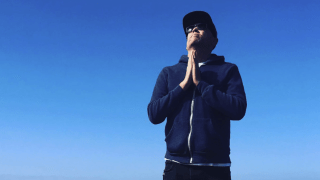City of Hope is showcasing stories of heroism, resilience and gratitude as the world grapples with the COVID-19 pandemic. This is just one of many stories of hope that is emerging from this global crisis.
Ian MacLeod does a lot more breathing these days. Deep, intentional breathing as an emotional response to COVID-19, and the fear and anxiety it is causing for cancer patients like him.
"The COVID-19 virus situation can bring to the surface a lot of the trauma that survivors like me felt in treatment, and also create a lot of mental chaos, a lot of turbulence, a lot of fear," said MacLeod, 40, who was diagnosed with acute myeloid leukemia (AML) seven years ago.

"I think it's because we as patients have spent so many days, hours and seconds in isolation in a hospital bed. For me, that was my deepest level of brokenness as a person and I can see how COVID-19 could be very traumatizing, maybe even a form of PTSD, for cancer patients."
The stifling sense of isolation, a consequence of social distancing, along with the fear that results from having lowered immunity and being susceptible to a novel virus, are emotions that MacLeod, who received a bone marrow transplant at City of Hope as part of the treatment for AML, fights daily.
But he also is convinced that by making certain spiritual, emotional and physical choices — and at the heart of those mindful, focused, intentional breathing — cancer patients can manage their fears around COVID-19.
"This period is temporary, honestly," said MacLeod, who is, among other vocations, a certified meditation teacher." This too shall pass, but unless we learn to sit and be with ourselves and foster self-love, self-forgiveness and self-compassion, this period of waiting will be very difficult."
Take 16 Seconds To Breathe
It takes MacLeod 16 seconds of mindful breathing — a breath in for four seconds, retaining that breath for four more seconds, releasing the held breath for four seconds, and holding the bottom of the exhale for four more seconds — to push the reset button on his emotional state.
It is a way of quickly calming down hypervigilant, anxious thought patterns; a way of dampening the fight or flight response in the brain that can take over during times of sustained stress.
16 Second Breathing Exercise
Marissa Cangin, Psy.D., an assistant clinical professor at City of Hope, and a licensed psychologist, agrees that focused breathing can calm your nervous system and may also give you something to focus on that is typically within your control. She suggests patients beginning a breath-centered practice consult with their physician to ensure it is safe for them.
MacLeod's approach to his own practice is to first create a quiet, silent space in his day by taking a slow, mindful walk, or meditating or praying. During those times, he is focused on how his breath travels in and out of his body.
"Breathing makes us present and if we can come into the room and be present, no matter where we are, then we can start to observe those feelings that we have inside, that tension and stress," he said. "Just sit with that, observe it. Don't try to change it, just witness it. Stay in the present and not focus on the past or the future, but be here in the moment.
"All of a sudden the thoughts transform and I'm like, 'Wow, I'm so lucky I'm breathing. I'm so lucky that I'm still here and I'm healthy.'"
Confront Difficult Emotions
One important element of fostering a sense of calm is to confront difficult emotions, according to MacLeod. Don't run from them, but sit with them.
"There were periods during cancer, and now COVID-19, where I felt very blue, so blue," he said. "And the key is, when we feel sad, or blue, or anxious, we run. We just run the other way. Just any way we can tune out from the real feelings."
Sit With Your Feelings
Instead of avoiding your feelings, MacLeod suggests meeting them head-on; observing how they show up in your thoughts; noticing how they feel in the body. Taking time to step outside of a reeling and unwieldy mind and acknowledge how you feel could be a step toward feeling differently.
"Just get still, and get silent and start to recognize these feelings and go, 'You know, why am I so mad?'" he said. "When we run towards the Bogeyman instead of running away … when we give fear a hug, it's not so fearful anymore."
Exercise The Body
Having a holistic view of health involves understanding how things like physical fitness impact mental health. Being sequestered at home, sharing space with family, homeschooling and dealing with things like depression, anxiety and PTSD related to COVID-19 can be barriers to getting physical.
Focus on What's Real
MacLeod suggests starting small, with things like taking a short walk, listening to guided meditations, or doing a few restorative yoga poses. Start small and gradually do these calming exercises for longer periods.
"For me, it's been a combination of taking a walk with my dog by myself and just getting out and really breathing in the oxygen in the air," said MacLeod. "And the best part is it's so quiet now, and there's no planes, no traffic, so really I can just walk with my dog, stay off my phone, and listen to the birds chirp and the wind in the trees. I marvel at nature. Just, wow, although there's chaos in the world nature is consistent."
Carve Out Emotional Calm Each Day
An important way MacLeod counters the anxiety around COVID-19 is by setting aside time and space every day to focus on calming his mind and body. He says making an appointment for self-care is critical.
"I start the day with meditation and setting an intention, and at the end of the day, around 4 or 5 p.m., I sit again and read a book, or read a scripture," he said. "I sit and really let the day go. So in the morning, I'm setting my intention of how I wanna approach my day.
Give Yourself a Blessing
"And by the end of the day, I'm letting go of all of the things that occurred, the things that didn't go well, whether it be co-workers, or spouse or children. And after moving on to dinner with my family, I am then able to really be in the moment and be grateful."
Practice Gratitude
It is easy, during an unprecedented time like the current COVID-19 pandemic, for thoughts to veer toward the negative — for our minds to focus on everything going wrong in our lives.
But MacLeod says that focusing on things about which you are grateful can be an emotional salve that counterbalances the inevitable negative feelings we are all feeling — the worst of which, for cancer patients, could be fear of dying.
Togetherness
"That fear of dying is real, I think, for everybody, but our thing is, when we feel fear, I think the best thing we can do is choose love," said MacLeod. "That's the polar of fear: love. Love can start with gratitude practices, saying, 'I'm grateful for this home that keeps me sheltered. I'm grateful for my family who keeps me warm and gives me love.'
"And we can take these moments to say, 'I'm grateful for clean water to drink and clean water to bathe in. And I'm grateful to live in a state and a country where we have first responders that take care of us.' And so there's just so much to focus on if you focus on gratitude and love instead of fear."
Take It Breath By Breath
MacLeod says his best advice for cancer patients is to use their own difficult experiences during treatment as a coping mechanism. Cangin agrees.
"Many of our cancer patients are already uniquely equipped to manage the many unknowns associated with this pandemic," she said. "It doesn't necessarily make it easier, but it becomes less foreign and the coping skills used to manage the unknowns of cancer can certainly serve one well in coping with COVID-19."
"For patients and survivors, we learn in the hospital that you don't take it day by day and you don't take it hour by hour. You take it breath by breath," he said. "So take it breath by breath today and we'll get through this."
For more information and resources, visit the City of Hope COVID-19 Resource Hub.
